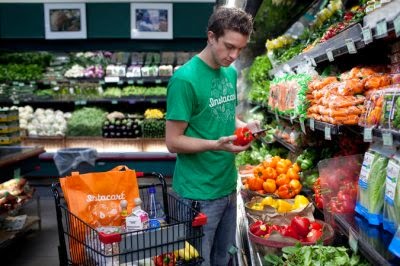Are you sending your child
to college this fall? If so fresh food
is top of mind for most campus dining rooms and that may not save you money,
but it may put save a freshman 10 lbs.
Each year for the past ten
years Y-Pulse has been tracking
foodservice trends through the nation’s leading foodservice directors in the
education segments to give food marketers insight on what would shape the
tastes of tomorrow’s consumers. We selected and parsed the top 7 findings for
you. Here they are:
Transparency Rules the Day Even when it comes to snacking, millennial
consumers want fresh and healthy snacks to feed their cravings on demand.
Eighty-three percent considered healthfulness an important criterion for the
snacks they chose. Today’s consumers want fresh, fast fuel for their bodies.
Fresh homemade taste has become the new definition of quality for young
consumers.
Wellness as a Way of Life: “Wellness policies have been in place for many years
in public schools and in a recent Y-Pulse study, 82% of colleges and
universities stated that their campus has a wellness policy or program in place.
Of the other 18% that did not have a formal policy, 45% said a program was
pending.
Not all Deep Fried: A combi oven in every kitchen is the dream of
school foodservice directors. When foodservice directors were asked if they
could have one new piece of equipment what would it be; 72% noted a new item of
cooking equipment and 37% of those identified a combi oven specifically.
Technology Enabled Connections: In a Y-Pulse study, 95% of foodservice directors in
college foodservice said they use social media to connect with their
foodservice customers. Eighty-five percent said social media tools are very
important or important for promoting foodservice venues. Foodservice directors are also handling
customer feedback in real time to continuously improve the relevance and
satisfaction of their foodservice programs. Campus dining apps are popping up
everywhere as operators look to connect their offerings with student lifestyles
and social media habits. These new apps allow students to track calories and
evaluate menus across campus in real time.
Community Enabled: Gardens are becoming part of the culinary landscape
as the farm to table movement continues to gain momentum. Schools and community
gardens bring people together, and some college campuses are serving up dinner
on the farm with locally grown foods.
Cooking Transparency: Display kitchens allow customers to enjoy the
experience of seeing their meal being prepared and feel more of a connection to
those preparing it. Bringing the kitchen out front has the added advantage of
building esteem for the kitchen staff by bringing them out of the back of the
house to center stage with customers.
The Global Kitchen: Today’s college age consumers are more diverse and
aware of global cultures and cuisines than any previous generation. Yet even
58% of K-12 foodservice directors say that almost all of their students expect
to see ethnic foods on the menu regardless of their ethnic background.
Latin, Mediterranean and Asian flavors have been
the top three ethnic cuisines for many years. Micro cuisines from all of these
regions of the world continue to emerge in surveys of chefs year after year.
Just a few years ago, a Y-Pulse study of middle school students indicated that
30% never ate Chinese or Mexican food although classic Italian foods like
spaghetti and pasta were among the top scoring favorites.
There is no denying the appeal of classic American
comfort food among all consumers. What’s new is how some of the ethnic flavors
are finding their way into mainstream American menu items.
Interested
in learning how the 5P’s of Food Marketing can edify your retail food brand
while creating a platform for consumer convenient meal participation, differentiation
and individualization Visit www.FoodserviceSolutions.us or Facebook.com/Steven Johnson,
Linkedin.com/in/grocerant or twitter.com/grocerant


No comments:
Post a Comment